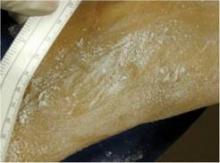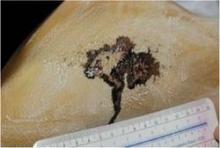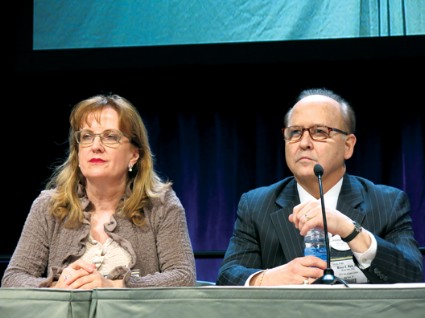User login
PHOENIX – Laser treatment of severe hyperhidrosis significantly reduced underarm sweating after 6 months in two separate but similar studies of 20 and 13 patients.
Patients with scores of 3 or 4 on the 4-point Hyperhidrosis Disease Severity Scale (HDSS) underwent a single treatment to acutely damage eccrine glands using a 1,440-nm Nd:YAG laser with a new 800-mcm side-firing fiber designed to deliver targeted energy. Patients received tumescent anesthesia in each axilla.
Sixteen of 20 patients in one study (78%) reported at least a 2-point improvement in HDSS scores at a 6-month follow-up visit, and 17 (83%) reported at least a 1-point improvement at 1 year, compared with baseline, Dr. Bruce Katz and his associates reported at the annual meeting of the American Society for Laser Medicine and Surgery.
Average HDSS scores were 3.6 before treatment, 2.3 at 3 months, 1.7 at 6 months, and 2.2 at 1 year, said Dr. Katz, a clinical professor of dermatology at Mount Sinai Hospital, New York.
The side-firing fiber inserted through a 150-mm handpiece and set at 10-15 W delivered 1,200-1,500 J to each of four 5 cm2 × 5 cm2 areas in each armpit. Both eccrine and apocrine glands were reduced based on post-treatment histological studies. Side effects included edema, bruising, and numbness, but these conditions resolved in 1-2 weeks.
Before the study, 13 patients (65%) had an HDSS score of 4. Five patients had tried treatment with botulinum toxin type A before the study and found it effective, with results lasting an average of 6 months, but they had discontinued that therapy because of the high cost, Dr. Katz said.
In a second study of 13 patients, HDSS scores improved by a mean of 1.3 at the 6-month follow-up visit, Dr. Alina Fratila and her associates reported in a separate presentation at the meeting.
Gravimetric measurements (in milligrams per minute) showed a mean 78% reduction in sweating at 6 months, said Dr. Fratila of the Fountain of Youth Clinic in Bonn, Germany.
Physicians rated the improvement in sweat as 71%, and patients rated it as 55%. The laser in this study was set at 7.5 W, delivering an average of 6,000 J per axilla (or 1,500 J per 5 cm2 × 5 cm2 quadrant).
Ten patients had tried a prescription antiperspirant prior to participating in the study, but they stopped because they found it either irritating or ineffective. Four patients had tried botulinum toxin therapy but stopped because of the cost, Dr. Fratila said.
The laser treatment has a low risk of side effects and causes essentially no downtime, Dr. Fratila said. She added that she plans to follow the patients to assess results after 1 and 2 years.
An estimated 3% of the U.S. population has primary focal hyperhidrosis, comprising nearly 8 million people, Dr. Katz said.
Other treatment options for primary focal hyperhidrosis include topical over-the-counter antiperspirants, aluminum chloride 10%-35% topical antiperspirant, intradermal injections of botulinum toxin type A, and surgical resection of local sweat glands.
Dr. Katz reported financial associations with Cynosure, which makes the laser systems used in his study, and with Allergan, Alma, and other companies. Dr. Fratila reported having no disclosures.
On Twitter @sherryboschert
PHOENIX – Laser treatment of severe hyperhidrosis significantly reduced underarm sweating after 6 months in two separate but similar studies of 20 and 13 patients.
Patients with scores of 3 or 4 on the 4-point Hyperhidrosis Disease Severity Scale (HDSS) underwent a single treatment to acutely damage eccrine glands using a 1,440-nm Nd:YAG laser with a new 800-mcm side-firing fiber designed to deliver targeted energy. Patients received tumescent anesthesia in each axilla.
Sixteen of 20 patients in one study (78%) reported at least a 2-point improvement in HDSS scores at a 6-month follow-up visit, and 17 (83%) reported at least a 1-point improvement at 1 year, compared with baseline, Dr. Bruce Katz and his associates reported at the annual meeting of the American Society for Laser Medicine and Surgery.
Average HDSS scores were 3.6 before treatment, 2.3 at 3 months, 1.7 at 6 months, and 2.2 at 1 year, said Dr. Katz, a clinical professor of dermatology at Mount Sinai Hospital, New York.
The side-firing fiber inserted through a 150-mm handpiece and set at 10-15 W delivered 1,200-1,500 J to each of four 5 cm2 × 5 cm2 areas in each armpit. Both eccrine and apocrine glands were reduced based on post-treatment histological studies. Side effects included edema, bruising, and numbness, but these conditions resolved in 1-2 weeks.
Before the study, 13 patients (65%) had an HDSS score of 4. Five patients had tried treatment with botulinum toxin type A before the study and found it effective, with results lasting an average of 6 months, but they had discontinued that therapy because of the high cost, Dr. Katz said.
In a second study of 13 patients, HDSS scores improved by a mean of 1.3 at the 6-month follow-up visit, Dr. Alina Fratila and her associates reported in a separate presentation at the meeting.
Gravimetric measurements (in milligrams per minute) showed a mean 78% reduction in sweating at 6 months, said Dr. Fratila of the Fountain of Youth Clinic in Bonn, Germany.
Physicians rated the improvement in sweat as 71%, and patients rated it as 55%. The laser in this study was set at 7.5 W, delivering an average of 6,000 J per axilla (or 1,500 J per 5 cm2 × 5 cm2 quadrant).
Ten patients had tried a prescription antiperspirant prior to participating in the study, but they stopped because they found it either irritating or ineffective. Four patients had tried botulinum toxin therapy but stopped because of the cost, Dr. Fratila said.
The laser treatment has a low risk of side effects and causes essentially no downtime, Dr. Fratila said. She added that she plans to follow the patients to assess results after 1 and 2 years.
An estimated 3% of the U.S. population has primary focal hyperhidrosis, comprising nearly 8 million people, Dr. Katz said.
Other treatment options for primary focal hyperhidrosis include topical over-the-counter antiperspirants, aluminum chloride 10%-35% topical antiperspirant, intradermal injections of botulinum toxin type A, and surgical resection of local sweat glands.
Dr. Katz reported financial associations with Cynosure, which makes the laser systems used in his study, and with Allergan, Alma, and other companies. Dr. Fratila reported having no disclosures.
On Twitter @sherryboschert
PHOENIX – Laser treatment of severe hyperhidrosis significantly reduced underarm sweating after 6 months in two separate but similar studies of 20 and 13 patients.
Patients with scores of 3 or 4 on the 4-point Hyperhidrosis Disease Severity Scale (HDSS) underwent a single treatment to acutely damage eccrine glands using a 1,440-nm Nd:YAG laser with a new 800-mcm side-firing fiber designed to deliver targeted energy. Patients received tumescent anesthesia in each axilla.
Sixteen of 20 patients in one study (78%) reported at least a 2-point improvement in HDSS scores at a 6-month follow-up visit, and 17 (83%) reported at least a 1-point improvement at 1 year, compared with baseline, Dr. Bruce Katz and his associates reported at the annual meeting of the American Society for Laser Medicine and Surgery.
Average HDSS scores were 3.6 before treatment, 2.3 at 3 months, 1.7 at 6 months, and 2.2 at 1 year, said Dr. Katz, a clinical professor of dermatology at Mount Sinai Hospital, New York.
The side-firing fiber inserted through a 150-mm handpiece and set at 10-15 W delivered 1,200-1,500 J to each of four 5 cm2 × 5 cm2 areas in each armpit. Both eccrine and apocrine glands were reduced based on post-treatment histological studies. Side effects included edema, bruising, and numbness, but these conditions resolved in 1-2 weeks.
Before the study, 13 patients (65%) had an HDSS score of 4. Five patients had tried treatment with botulinum toxin type A before the study and found it effective, with results lasting an average of 6 months, but they had discontinued that therapy because of the high cost, Dr. Katz said.
In a second study of 13 patients, HDSS scores improved by a mean of 1.3 at the 6-month follow-up visit, Dr. Alina Fratila and her associates reported in a separate presentation at the meeting.
Gravimetric measurements (in milligrams per minute) showed a mean 78% reduction in sweating at 6 months, said Dr. Fratila of the Fountain of Youth Clinic in Bonn, Germany.
Physicians rated the improvement in sweat as 71%, and patients rated it as 55%. The laser in this study was set at 7.5 W, delivering an average of 6,000 J per axilla (or 1,500 J per 5 cm2 × 5 cm2 quadrant).
Ten patients had tried a prescription antiperspirant prior to participating in the study, but they stopped because they found it either irritating or ineffective. Four patients had tried botulinum toxin therapy but stopped because of the cost, Dr. Fratila said.
The laser treatment has a low risk of side effects and causes essentially no downtime, Dr. Fratila said. She added that she plans to follow the patients to assess results after 1 and 2 years.
An estimated 3% of the U.S. population has primary focal hyperhidrosis, comprising nearly 8 million people, Dr. Katz said.
Other treatment options for primary focal hyperhidrosis include topical over-the-counter antiperspirants, aluminum chloride 10%-35% topical antiperspirant, intradermal injections of botulinum toxin type A, and surgical resection of local sweat glands.
Dr. Katz reported financial associations with Cynosure, which makes the laser systems used in his study, and with Allergan, Alma, and other companies. Dr. Fratila reported having no disclosures.
On Twitter @sherryboschert
AT LASER 2014
Key clinical point: Patients with severe hyperhidrosis who underwent laser treatment had minimal, short-term side effects and essentially no downtime.
Major finding: HDSS scores of underarm sweating 6 months after laser treatment improved by at least 2 points in one study and by a mean of 1.3 points in another study.
Data source: Separate single-center, uncontrolled trials of 20 and 13 patients, respectively, with severe primary focal hyperhidrosis.
Disclosures: Dr. Katz reported financial associations with Cynosure, which makes the laser systems used in the study, and with Allergan, Alma, and other companies. Dr. Fratila reported having no disclosures.



